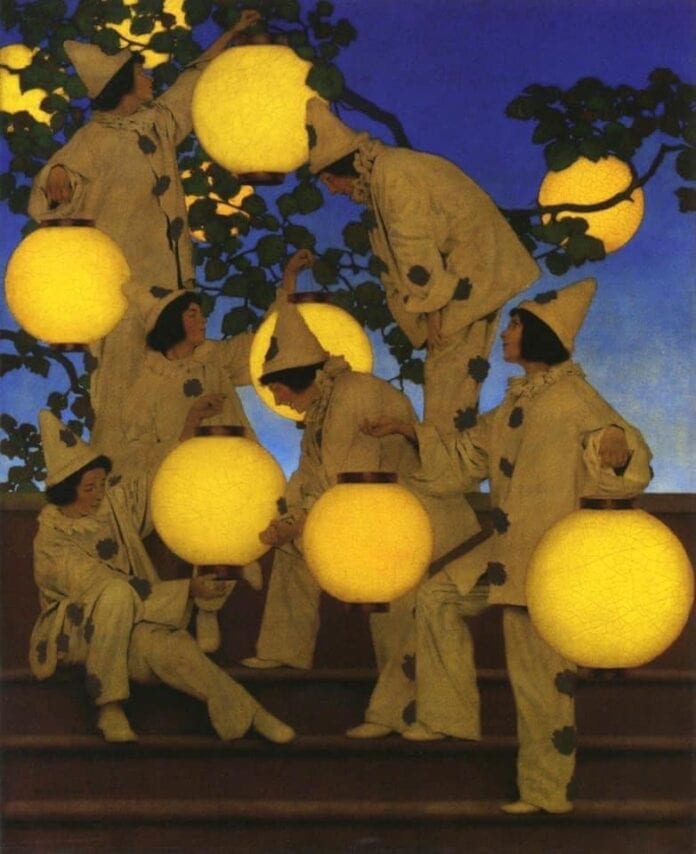They are telling their enchanting story on the wall just outside my studio—holding and lifting and hanging giant globes of amber light. Wearing matching conical hats and dressed alike as six versions of the famous French clown Pierrot, accessorized with ruffled collarets and large black pompom buttons, they are all clothed in roomy white blouses and wide white pantaloons.
I have a costume just like theirs, now tucked away on the top shelf of my studio closet. When my daughter was in the second grade her French teacher asked me to visit her class and mime as Pierrot. I stitched up my outfit, whitened my face, rouged my cheeks and spent a fun afternoon playing my part.
Pierrot, whose origins were in a late seventeenth-century Italian troupe of players performing in Paris, was a stock character of pantomime and commedia dell’arte. With his physical insularity and lapses into mutism and his unworldly naïveté, he became a mythical alter ego for the famously alienated artists of the nineteenth and twentieth centuries.
The bevy of Pierrots outside my studio are actually figures in a framed postcard of a large oil painting—the famous “The Lantern Bearers”, by Maxfield Parrish. Painted by Parrish in 1908 with saturated colors and glazes, this evocative night scene now resides just down the road in the Crystal Bridges Museum. When the painting went on the Christie’s auction block in 2006, Alice Walton stepped up to make the purchase for over $4 million for her museum. My first time seeing “The Lantern Bearers” there, with all my heart I wanted to bring the original home, but, alas, I had to settle for a postcard!
Maxfield Parrish (1870-1966), whose given name was Frederick Parrish, adopted his Grandmother’s maiden name, Maxfield, as his professional name. Raised in a Quaker society, as a child he drew for his own amusement. When his talent was recognized by his parents, they encouraged him and took him to Europe between 1884 and 1886. He attended Haverford College, the Pennsylvania Academy of Fine Arts and the Drexel Institute of Art, Science and Industry. Settling in Plainfield, New Hampshire near the Cornish Art Colony, Parrish entered into an artistic career that lasted more than fifty years, painting to age 91. Also an avid machinist, he frequently referred to himself as “a mechanic who loved to paint”.
Parrish did not shun painting to popular appeal. He recognized that to enjoy big success depended on mass reproductions. Many of his early works were rendered in black and white. He made almost 900 pieces of art including book and magazine covers and illustrations, as well as calendars and greeting cards. Photography became an integral part of his artistic process. Instead of spending hours of drawing from actual models, rather he took photographs, using this innovative technique as a form of artistic shorthand.
In 1904, Parrish signed an exclusive contract with Collier’s magazine stating that his future work would be published solely in Collier’s until 1910. He received $1,250 a month and retained all the original paintings made for the magazine. “The Lantern Bearers” was painted near the end of this period and appeared on the cover of the December 10, 1910 issue. By then Parrish was earning over $100,000 per year, when homes could be bought for $2,000.
As contributor to Startle.com, Amanda Lampel, writes, “By 1925, Parrish’s name was ubiquitous in American households. A staggering one-fourth of American homes had a Parrish print adorning its walls. An art print publisher survey revealed that, at this time, Americans thought of Parrish in the same ranks as Cezanne and van Gogh.”
Rich with atmosphere, “The Light Bearers”, my favorite of all of Parrish’s works, displays his strong sense of romance and his great sense of characterization. As a tour de force of luminosity—delicate and elegant, filled with compositional complexity and detail—the painting shows a masterful handling of paint and a keen understanding of color. The background shade of lapis lazuli blue eventually became eponymous as Parrish blue.
The work of Maxfield Parrish remains appreciated today, not just by me and visitors to Crystal Bridges. Andy Warhol collected his work. Elton John’s album “Caribou” has a Parrish background. The Moody Blues album “The Present” uses a variation of a Parrish painting. The Irish musician Enya has been inspired by his imagery for her albums and videos including “In Memory of Trees” and “Caribbean Blue”.
Maxfield Parrish, the master of “The Lantern Bearers”, continues to enchant us!


















